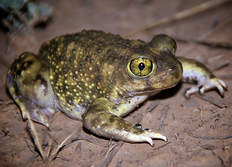 The other day my friend Sabra regaled me with spadefoot toad stories that caught my hair on fire. Toads and frogs need water to thrive and the lack of rain has left me feeling paralyzed and obsessed at the same time over a thirst driven desert, and missing my liminal amphibious friends dearly. Listening to her talking about the toad holes in her garden - Sabra literally waters these round depressions every night until resident toads pop their heads out of the hole with their tongues sticking out! One year someone had made a sort of trench in the arroyo below Sabra’s house and it filled with water. One night they heard such a racket, that she thought a truck was stuck, and ran down the canyon and discovered that the toads were singing! These stories of hers made me realize that I feel exactly like a toad myself. I am starved for water from the sky. Every morning before I walk down to the river at dawn I turn on the sprinkler in front of the house to water the chamisa to keep one area green, but also to create a bathing area for the hummingbirds and other birds who take early morning baths under the spray. Everyone needs water…and I keep hoping that a toad or two might find this temporary early morning oasis at some point and move in. So far, no toads…my guess is that I would need a more permanent source of water, not to mention less heat (because most toads cannot survive temperatures above 86 degrees) to have some visit. Last year I heard one western toad and found one dead on the road, run over by a car. She was probably on her way to meet her croaking male suitor. No toad eggs appeared in Iren’s little pond, so my guess is that this female was the only other toad in the area. After Sabra told me about the spadefoots I immediately looked them up wondering if they also live down here by the river. Listening to the spadefoot’s call so I could recognize it, I was surprised at how different the calls of spadefoot sounded from the others – a weird grating sound. I also learned that the spadefoot is found in all of New Mexico’s 33 counties but I was not able to determine precisely where they prefer to live (Sabra lives on the Mesa). Some sources say they burrow near ponds and low areas but obviously they also like Mesas if they have a water source like Sabra does. When I learned that they were nocturnal, secretive, and totally dependent upon rain I realized I might have one in my area and not know it? I needed to learn that call. Distinguished by eyes with vertical pupils (other toads have horizontal pupils) that sit close to the top of their heads and small, hard, wedge-shaped structures on hind legs used for digging into moist soil, spadefoot toads vary in color (between gray, brown or dusky green). They are approximately 1.5 to 3.5 inches in length and when threatened they emit an odor said to smell like roasted peanuts. These toads can survive temperatures above 98 degrees, unlike most other toads. The amazing thing about spadefoots is that they spend most of the year underground in cocoons formed from layers of shed skin. This shedding of skins helps keep the toad from 'drying out' or dehydrating, and they stay alive in a state of ‘suspended animation’ called estivation. Some burrow three feet down in the ground. When summer rains fill low areas with water they emerge to feed for the year on insects (termites, ants, beetles and spiders but not worms as Sabra feared) and to breed. The males do the calling. Breeding takes place in temporary pools. Around a thousand eggs are laid in large masses and often hatch in as little as 48 hours. The tadpoles are forced to metamorphose in 7 – 13 days, the fastest developing of all toads. If the tadpoles hatch, little toadlets will eat frantically (they are omnivorous too) and burrow into the ground to wait for the next downpour. With this drought I can’t imagine water remaining above ground long enough for tadpoles to survive, even if we do have rainfall. The earth is so parched. It does not surprise me that most of the seven species of spadefoots are under threat of extinction, especially with global warming. Most sources say they are not ‘true toads’ because they do not have warty skin and they have teeth! Talk about living on the edge – wow – the fact that these amphibians have survived at all is a source of mind-bending amazement to me.
0 Comments
Your comment will be posted after it is approved.
Leave a Reply. |
Submit your ideas for local feature articles
Profiles Gardening Recipes Observations Birding Essays Hiking AuthorsYou! Archives
October 2025
Categories
All
|
 RSS Feed
RSS Feed